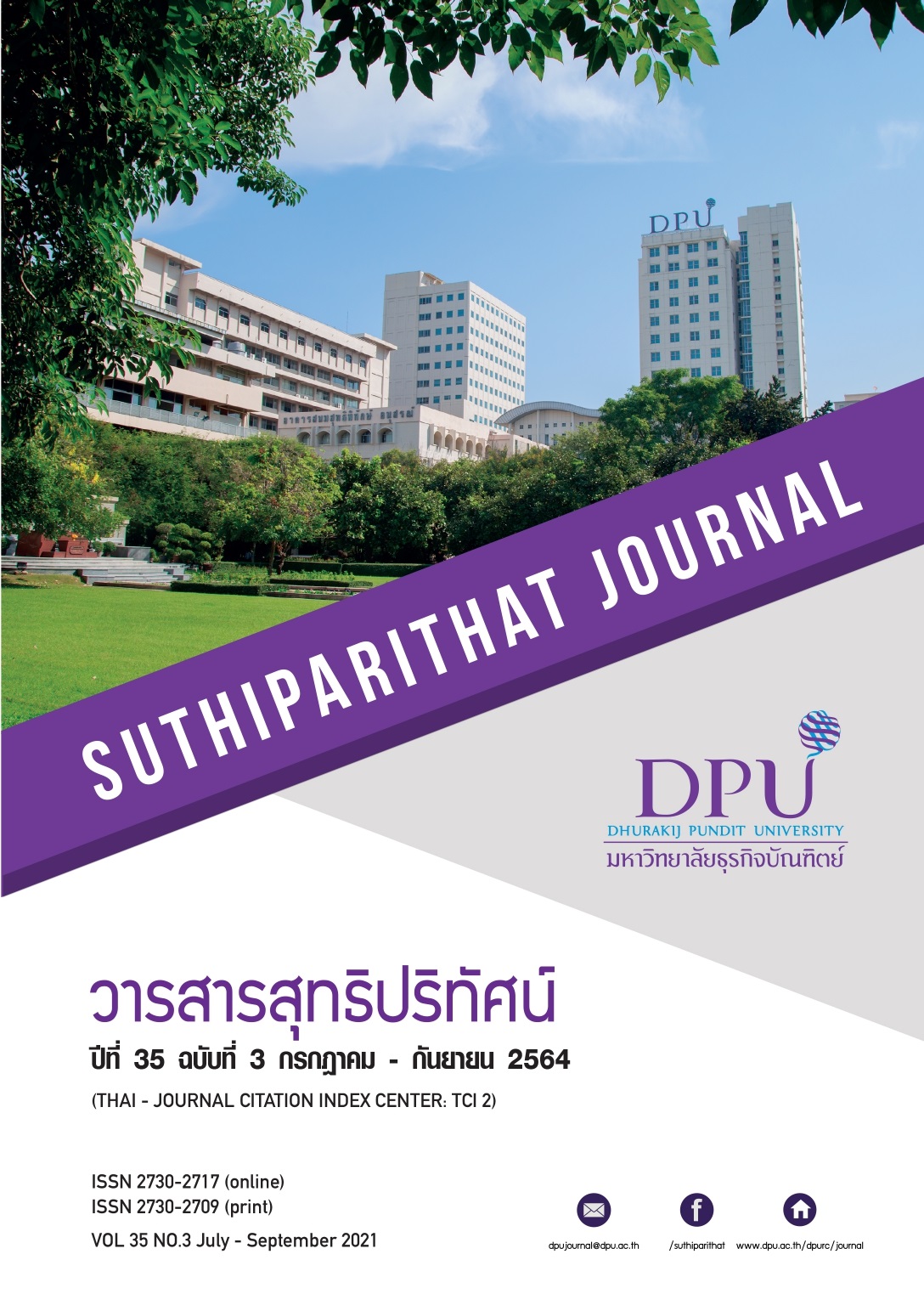ผลกระทบหลักสูตรวัฒนธรรมข้ามชาติและทัศนคติสากลต่อความฉลาดทางวัฒนธรรม กรณีศึกษานักศึกษาระดับปริญญาตรีในมหาวิทยาลัยเอกชนของไต้หวัน
คำสำคัญ:
ความฉลาดทางวัฒนธรรม, สมรรถนะข้ามวัฒนธรรม (ICC), บริบทของไต้หวัน, ทัศนคติสากลบทคัดย่อ
รายงานการศึกษาเกี่ยวกับการทดลองนี้มุ่งที่จะศึกษาความสามารถหลักของความฉลาดทางวัฒนธรรมของนักศึกษาระดับปริญญาตรีในมหาวิทยาลัยเอกชนของไต้หวัน กล่าวคือ นครไทเปกำลังได้รับความนิยมอย่างรวดเร็วในระดับนานาชาติ ด้วยเหตุนี้นักศึกษามหาวิทยาลัยจึงมีแนวโน้มว่าจะได้พบและร่วมงานกับเพื่อนร่วมงานและผู้คนจากหลายประเทศในระหว่างการทำงาน ดังนั้นการตระหนักให้เพิ่มความฉลาดทางวัฒนธรรมให้แก่นักศึกษามหาวิทยาลัยจึงสูงขึ้นในทุกวัน ความฉลาดทางวัฒนธรรมคือความสามารถ ซึ่งจะเพิ่มศักยภาพของนักศึกษาในการปฏิสัมพันธ์กับผู้ที่มาจากวัฒนธรรมอื่นได้อย่างมีประสิทธิภาพ วัตถุประสงค์ของการศึกษานี้เพื่อตรวจสอบผลกระทบของหลักสูตรความคิดข้ามวัฒนธรรมและทัศนคติสากล ซึ่งมีส่วนผสมผสานระหว่างประวัติศาสตร์และทฤษฎีข้ามวัฒนธรรมที่เกี่ยวกับความฉลาดทางวัฒนธรรม ซึ่งวัดจากการสำรวจความฉลาดทางวัฒนธรรม ข้อมูลสำหรับการศึกษานี้ได้รวบรวมจากนักศึกษาระดับปริญญาตรี 70 คนในมหาวิทยาลัยเอกชนแห่งหนึ่งในไทเป สาธารณรัฐไต้หวัน โดยใช้แบบทดสอบก่อนและหลังการเรียน วิเคราะห์ด้วยสถิติ t- test การศึกษานี้ได้เปลี่ยนแปลงมิติการสำรวจความฉลาดทางวัฒนธรรมของนักศึกษาในเรื่องทัศนคติที่มีต่อวัฒนธรรมอื่น ๆ เมื่อสิ้นสุดภาคเรียนที่มีระยะเวลาทั้งสิ้น 18 สัปดาห์ (36 ชั่วโมง) ผลการวิจัยพบว่า มีการเปลี่ยนแปลงในเชิงบวกจากการตอบแบบสำรวจความฉลาดทางวัฒนธรรมหลังเรียน
เอกสารอ้างอิง
Andresen, M., & Bergdolt, F. (2017). A systematic literature review on the definitions of global mindset and cultural intelligence: Merging two different research streams. The International Journal of Human Resource Management, 28(1), 170-195. doi: 10.1080/09585192.2016.1243568
Ang, S., & Van Dyne, L. (2008). Handbook of cultural intelligence: Theory, measures and applications. Armonk: M.E. Sharpe.
Ang, S., Van Dyne, L., & Koh, C. (2007). Cultural intelligence: Its measurement and effects on cultural judgment and decision making, cultural adaptation and task performance. Management and Organization Review, 3, 335-371.
Ang, S., Van Dyne, L., Koh, C., Ng, K. Y., Templer, K. L., Tay, C., & Chandrasekar, N. A. (2015). Cultural intelligence: Its measurement and effects on cultural judgment and decision making, cultural adaptation and task performance. Management and Organization Review, 3(3), 335-371. doi: 10.1111/j.1740-8784.2007.00082.x
Bücker, J., & Poutsma, E. (2010). Global management competencies: A theoretical foundation. Journal of Managerial Psychology, 25, 829–844. doi:10.1108/02683941011089116
Byram, M. (1997). Teaching and assessing intercultural communicative competence. Clevedon, UK: Multilingual Matters.
Cai, M. (2019). Reflection of cultural difference of the east and the west in nonverbal communication Advances in Social Science, Education and Humanities Research, 311, 288-297.
Charles, M., & Marschan-Piekkari, R. (2002). Language training for enhanced horizontal communication: A challenge for MNCs. Business Communication Quarterly, 65(2), 9-29.
Deardorff, D. K. (2004). The identification and assessment of intercultural competence as a student outcome of international education at institutions of higher education in the United States (Doctoral dissertation). Raleigh: North Carolina State University.
Dervin, F. (2012). Impostures interculturelles. L’ Harmattan.
Fang, T. (2006). From “onion” to “ocean”. International Studies of Management and Organization, 35(4), 71–90.
Fang, T. (2012). Yin yang: A new perspective on culture. Management and Organization Review, 1–26.
Gardner, R. C. (2001). Integrative motivation and second language acquisition. In Z. Do¨rnyei & R. Schmidt (Eds.), Motivation and Second Language Acquisition (pp. 1-20). Honolulu, HI: University of Hawaii Press.
Hall, E. T., & Hall, T. (1959). The silent language. Anchor books.
Halliday, M. A. K. (1978). Language as a social semiotic. London: Edward Arnold.
Hofstede, G. (1980). Culture’s consequences: International differences in work-related values. Beverly Hills, CA: Sage.
Hofstede, G. (2001). Culture's consequences: Comparing values, behaviors, institutions and organizations across nations. USA: Sage Publications.
Hofstede, G. (2003). Culture's consequences: Comparing values, behaviors, institutions and organizations across nations. USA: Sage Publications.
House, R. J., Hanges, P. J., Javidan, M., Dorfman, P. W., & Gupta, V. (2004). Culture, leadership, and organizations: The GLOBE study of 62 societies. USA: Sage Publications.
Louhiala-Salminen, L., Charles, M., & Kankaanranta, A. (2005). English as a lingua franca in Nordic corporate mergers: Two case companies. English for Specific Purposes, 24(4), 401–421.
Ly, A. (2012). Making sense of communication and cultural differences in the workplace: The case of Sino-Scandinavian Collaborations. In F. Dervin & R. Machart (Eds.), Intercultural Communication with China Beyond (Reverse) Essentialism and Culturalism? (pp. 111-131). Singapore: Higher Education Press and Springer.
Ly, A. (2013). A critical discussion of Hofstede’s concept of Power. SYNAPS, 28, 51–66.
McSweeney, B. (2002). Hofstede’s model of national cultural differences and their consequences: A triumph of faith—A failure of analysis. Human Relations, 55(1), 89–118.
Ng, K. Y., & Earley, C. P. (2006). Culture and intelligence: Old constructs, new frontiers. Group and Organization Management, 31, 4-19.
Nunnally, J., & Bernstein, I. (1994). Psychometric theory (3rd ed.). New York: McGraw-Hill.
Osland, J., & Bird, A. (2000). Beyond sophisticated stereotyping: Cultural sensemaking in context. Academy of Management Executive, 14(1), 65-77.
Piller, I. (2011). Intercultural communication: A critical introduction. Edinburgh: Edinburgh University Press.
Sackmann, S. A., & Phillips, M. E. (2004). Contextual influences on culture research: Shifting assumptions for new workplace realities. International Journal of Cross-Cultural Management, 4(3), 370–390.
Søderberg, A.-M., & Holden, N. (2002). Rethinking cross-cultural management in a globalizing business world. International Journal of Cross-Cultural Management, 2, 103–121.
Stening, B. W., & Zhang, M. Y. (2007). Methodological challenges confronted when conducting management research in China. International Journal of Cross-Cultural Management, 7(1), 121–142.
Tanveer, A., Mouratidis, H., & Preston, D. (2009). Website design guidelines: High power distance and high-context culture. International Journal of Cyber Society and Education, 2(1), 47-60.
Wang, J. (2008). A cross-cultural study of daily communication between Chinese and American: From the perspective of high context and low context. Asian Social Science, 4(10), 151-154.
Yang, P. (2010). Managing miànzi in Mandarin Chinese talk-in-interaction: A nonverbal perspective. Semiotica, 181. doi: 10.1515/semi.2010.041
Yang, P. (2013). Nonverbal communication in Mandarin Chinese talk-in-interaction. Saarbrücken, Germany: LAP Lambert Academic Publishing.
ดาวน์โหลด
เผยแพร่แล้ว
รูปแบบการอ้างอิง
ฉบับ
ประเภทบทความ
สัญญาอนุญาต
เนื้อหาและข้อมูลในบทความที่ลงตีพิมพ์ในวารสารสุทธิปริทัศน์ ถือเป็นข้อคิดเห็นและความรับผิดชอบของผู้เขียนบทความโดยตรงซึ่งกองบรรณาธิการวารสาร ไม่จำเป็นต้องเห็นด้วย หรือร่วมรับผิดชอบใด ๆ
บทความ ข้อมูล เนื้อหา รูปภาพ ฯลฯ ที่ได้รับการตีพิมพ์ในวารสารสุทธิปริทัศน์ ถือเป็นลิขสิทธิ์ของวารสารสุทธิปริทัศน์หากบุคคลหรือหน่วยงานใดต้องการนำทั้งหมดหรือส่วนหนึ่งส่วนใดไปเผยแพร่ต่อหรือเพื่อกระทำการใด ๆ จะต้องได้รับอนุญาตเป็นลายลักษณ์อักษรจากวารสารสุทธิปริทัศน์ก่อนเท่านั้น







